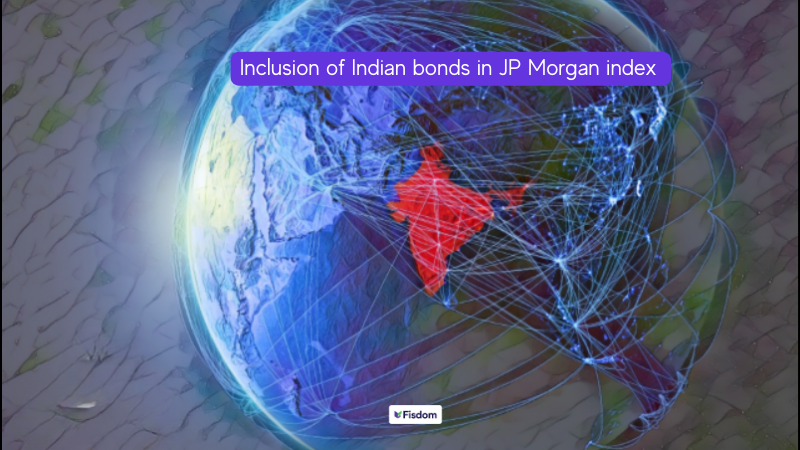
In a significant move that marks a new chapter in India’s journey towards becoming a sought-after investment destination and a leading global economic powerhouse, JPMorgan Chase & Co. has announced the inclusion of Indian Government Bonds (IGBs) into its benchmark Emerging Market index.
Starting from June 28, 2024, the process of incorporating IGBs into the Global Diversified Index (GBI-EM GD) will commence. The inclusion will be staggered over a period of ten months, ultimately leading to India achieving a maximum weightage of 10% in the GBI-EM GD. Notably, the GBI-EM GD accounts for approximately $213 billion of the estimated $236 billion benchmarked into the GBI-EM family of indices.
Read More – What are Tax-Free Bonds & How to Invest in it?
India’s journey to global economic inclusion
Indian bonds entering JP Morgan’s Benchmark Emerging Market Bonds Index is particularly noteworthy as India was the last major emerging market yet to join other countries like China on the global debt indices. This milestone decision comes after almost a decade of intense negotiations, preparations, and governmental efforts. It underscores India’s growing prominence in the global economic landscape.
The inclusion process will progress over ten months with 1 per cent increments on the index weighting. The country is expected to reach the maximum weighting of 10 per cent as per JP Morgan. Nearly two dozen Indian government bonds, with a combined notional value of $330 billion, will be eligible for inclusion.
Financial impact of Indian bond inclusion in the JP Morgan benchmark index
This move could trigger total flows of around $45-50 billion over the next 12-15 months alone. To put that into perspective, India has received total bond inflows of around $40 billion over the last decade, amounting to under 2 per cent of the total issue size. However, the actual annual flows may vary, depending on the underlying macro dynamics and momentum of active as well as passive flows.
While JP Morgan’s decision is a significant one, it does not automatically lead to India’s inclusion in other global bond indices such as the FTSE EM Index and the Bloomberg Barclays EM bond index. Inclusion in these indices depends on addressing operational hurdles such as custody and settlement, clarity on taxation, and Euroclear.
Impact on Indian Economy and Bond Market
Here are some of the positive influences that we may likely see on the Indian economy:
- The inclusion of Indian government bonds in a benchmark bond index could lead to larger and sustainable portfolio inflows.
- This move could significantly help in managing India’s twin deficits, namely Fiscal and Current account deficits.
- It may also decrease India’s investment risk and the cost of borrowing.
- The depth of India’s bond markets could be enhanced, increasing the availability of money.
- The ownership base of G-Secs (Government Securities) could be expanded, contributing to a more stable currency exchange rate.
Implications for businesses and banks
Some of the ways in which the Indian bond inclusion in JP Morgan’s Emerging Market Index will help businesses and banks are:
- Businesses stand to benefit as the entire interest rate spectrum is likely to drop slightly, leading to decreased borrowing costs over time.
- The difference between corporate and government bond yields is expected to narrow due to positive market trends.
- Commercial banks will also see benefits as they won’t need to buy as many government bonds as before. This will free up their balance sheets, enabling them to lend more to needy private sector segments in the economy.
Reduced cost of borrowing
The inclusion of Indian government bonds in JPMorgan’s Emerging Market Bond Index is expected to significantly lower the government’s borrowing costs in the next fiscal year. This move, which could lead to an estimated $23.6 billion influx from foreign portfolio investors between July 2024 and May 2025, is set to increase demand from new investors and reduce the rate cycle in the second half of the fiscal year 2025. The impact on government security yields will become evident as foreign investment inflows start via the Fully Accessible Route (FAR), a mechanism that allows unrestricted investments in government securities by foreign portfolio investors.
India is currently on its way to building the infrastructure it needs. With public debt having risen faster and lagging the savings rate, bond inclusion can provide a sustainable source of long-term financing through investment in government securities.
Conclusion
While the inclusion in the global indices is a significant step forward, it’s important to remember that the underlying macroeconomic scenario will always be crucial. Operational hurdles need to be addressed, and the spotlight will now be squarely on government finances and fiscal responsibility. However, the ongoing reform process, easier market access and transparency will shape and hasten India’s integration into global markets, paving the way for unparalleled market development, long-term capital inflows, and innovative financial products. This inclusion marks a new chapter in India’s journey towards becoming a global economic powerhouse.



























